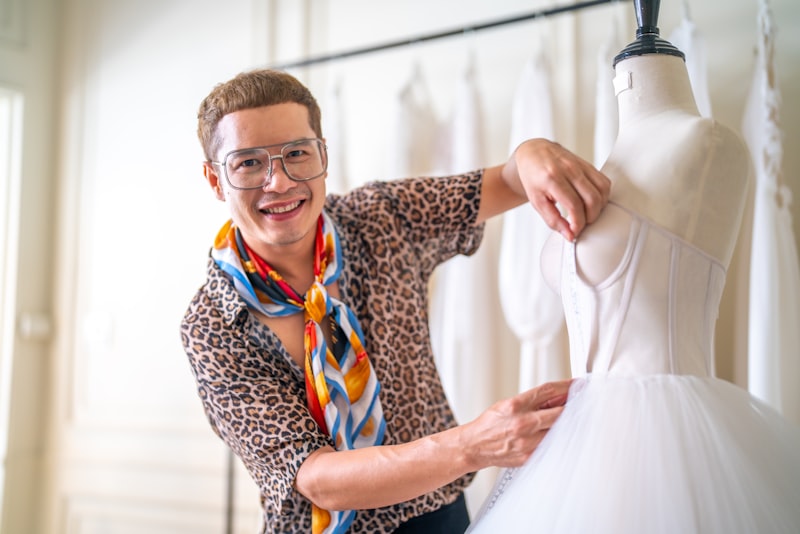Key Responsibilities of a Wedding Dress Designer During Fittings
Key Responsibilities of a Wedding Dress Designer During Fittings
Understanding the Role of a Wedding Dress Designer
When it comes to planning the perfect wedding, every detail matters, especially the bridal gown. A wedding dress designer plays a crucial role in this process, particularly during fittings. This article will explore the key responsibilities of a wedding dress designer during fittings, ensuring that every bride has a perfect experience leading to her big day.
What is a Wedding Dress Fitting?
A wedding dress fitting is a scheduled appointment where a bride tries on her wedding gown to assess its fit, design, and overall look. This pivotal moment involves adjustments and discussions between the bride and the designer. The success of a fitting often relies on several key responsibilities that a wedding dress designer must undertake.

Key Responsibilities of a Wedding Dress Designer During Fittings
| Responsibility | Description |
| 1. Initial Assessment | The designer should evaluate the fit of the dress on the bride and note any areas that require adjustments. |
| 2. Communicating with the Bride | Effective communication to understand the bride's vision and preferences is crucial for satisfaction. |
| 3. Making Adjustments | The designer is responsible for making necessary alterations to ensure a perfect fit and enhance the gown's beauty. |
| 4. Offering Suggestions | Based on the bride's body type and personal style, the designer should offer suggestions for how to improve the gown's design. |
| 5. Quality Control | Ensuring that the fabric and craftsmanship meet the highest standards. |
| 6. Planning Future Fittings | Setting a timeline for subsequent fittings to ensure that the dress is ready on time. |
1. Initial Assessment
During the first fitting, the wedding dress designer must conduct a thorough initial assessment. This involves inspecting how the dress fits various parts of the bride's body, focusing on areas such as the waist, bust, and hemline. By keenly observing how the fabric drapes and flows, the designer can identify needed modifications, serving as a foundation for the rest of the fitting process.
2. Communicating with the Bride
Communication is essential in establishing a rapport with the bride during fittings. A wedding dress designer must ask open-ended questions to understand her vision clearly. Such discussions may cover topics like preferred styles, favorite colors, and the overall theme of the wedding. This two-way communication helps create a more personalized experience, ensuring that the final design aligns with the bride’s expectations.
3. Making Adjustments
Once the initial assessment and communication are complete, the designer moves on to making necessary adjustments. This may involve taking in seams, letting out fabric, or modifying elements of the gown such as sleeves or embellishments. The goal is to create a comfortable fit while maintaining the gown's intended aesthetic. Providing immediate feedback on how the alterations affect the dress is vital for the bride’s peace of mind.
4. Offering Suggestions
While a bride may have a clear vision, a designer’s expertise can enhance that vision significantly. During fittings, designers have the responsibility to provide suggestions tailored to the bride’s unique style and body shape. Whether it's recommending a different neckline that flatters her figure or adjusting the skirt type for better movement, these insights can lead to a more stunning final product.
5. Quality Control
In addition to fit and design, a wedding dress designer must carry out quality control throughout the fitting process. This means examining the fabric's condition and checking the stitching and other details. If any issues arise, they should be promptly addressed to avoid complications as the wedding day approaches. High-quality craftsmanship is non-negotiable as it directly affects the bride's comfort and the gown's overall presentation.
6. Planning Future Fittings
After the first fitting, it is essential for the designer to outline a clear timeline for future fittings. Each fitting should ideally be spaced out, allowing time for further adjustments in the gown. The designer should ensure that the final gown is completed well ahead of the wedding date to account for any last-minute changes that the bride may want.
The Importance of Collaboration
Collaboration between the bride and designer is key to a successful fitting process. Each fitting is an opportunity to refine the gown and deepen the connection between both parties. The designer must remain patient and receptive to feedback throughout this stage. To ensure ongoing collaboration, it is helpful to document the bride’s preferences and any agreed-upon changes during each fitting session.
Bridal Trends to Consider
As wedding trends evolve, designers must also stay updated on emerging styles and fabrics. Popular trends may include sustainable fabric choices, vintage lace, or customizable elements that allow brides to put their unique stamp on their gowns. Staying current not only enhances the designer's portfolio but can greatly benefit the bride by offering a contemporary perspective during fittings.
Conclusion: Maximizing the Fitting Experience
In summary, the role of a wedding dress designer during fittings is multi-faceted, encompassing assessment, communication, adjustments, suggestions, quality control, and planning. Through diligent attention to these responsibilities, a designer can significantly enhance a bride's fitting experience and overall satisfaction. Remember, the journey to finding the perfect wedding gown is a collaborative process that requires patience, creativity, and open communication. By prioritizing these elements, both the designer and bride can ensure a seamless and enjoyable experience, creating a gown that perfectly encapsulates the bride's vision for her special day.
As a bride-to-be, consider scheduling your fittings well ahead of your wedding date, remain open to suggestions from your designer, and communicate your vision clearly for the best possible outcome. After all, your wedding day is one of the most important chapters of your life, and everything, including your wedding gown, needs to be just right.
